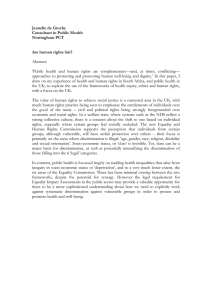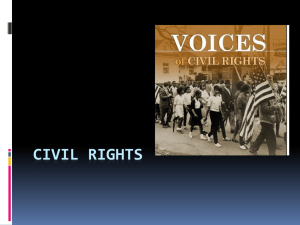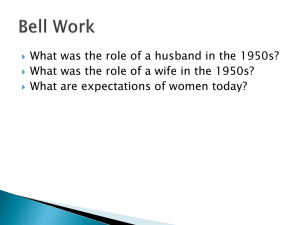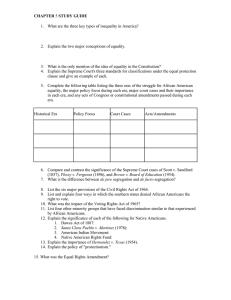C 5 HAPTER OUTLINE
advertisement
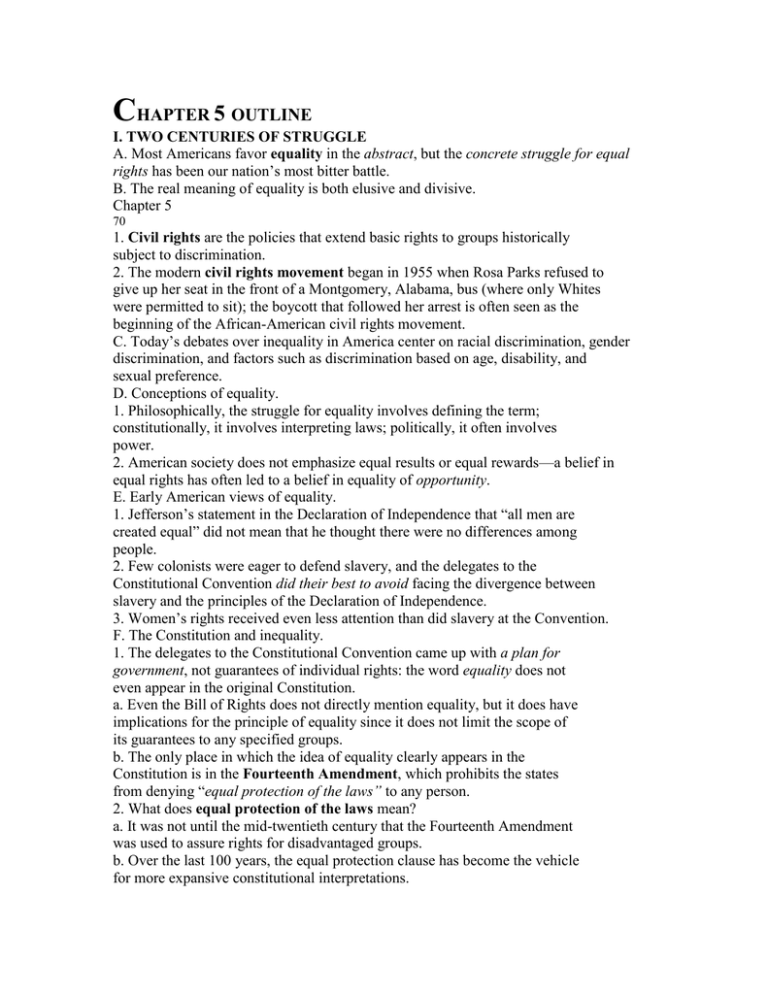
CHAPTER 5 OUTLINE I. TWO CENTURIES OF STRUGGLE A. Most Americans favor equality in the abstract, but the concrete struggle for equal rights has been our nation’s most bitter battle. B. The real meaning of equality is both elusive and divisive. Chapter 5 70 1. Civil rights are the policies that extend basic rights to groups historically subject to discrimination. 2. The modern civil rights movement began in 1955 when Rosa Parks refused to give up her seat in the front of a Montgomery, Alabama, bus (where only Whites were permitted to sit); the boycott that followed her arrest is often seen as the beginning of the African-American civil rights movement. C. Today’s debates over inequality in America center on racial discrimination, gender discrimination, and factors such as discrimination based on age, disability, and sexual preference. D. Conceptions of equality. 1. Philosophically, the struggle for equality involves defining the term; constitutionally, it involves interpreting laws; politically, it often involves power. 2. American society does not emphasize equal results or equal rewards—a belief in equal rights has often led to a belief in equality of opportunity. E. Early American views of equality. 1. Jefferson’s statement in the Declaration of Independence that “all men are created equal” did not mean that he thought there were no differences among people. 2. Few colonists were eager to defend slavery, and the delegates to the Constitutional Convention did their best to avoid facing the divergence between slavery and the principles of the Declaration of Independence. 3. Women’s rights received even less attention than did slavery at the Convention. F. The Constitution and inequality. 1. The delegates to the Constitutional Convention came up with a plan for government, not guarantees of individual rights: the word equality does not even appear in the original Constitution. a. Even the Bill of Rights does not directly mention equality, but it does have implications for the principle of equality since it does not limit the scope of its guarantees to any specified groups. b. The only place in which the idea of equality clearly appears in the Constitution is in the Fourteenth Amendment, which prohibits the states from denying “equal protection of the laws” to any person. 2. What does equal protection of the laws mean? a. It was not until the mid-twentieth century that the Fourteenth Amendment was used to assure rights for disadvantaged groups. b. Over the last 100 years, the equal protection clause has become the vehicle for more expansive constitutional interpretations. 3. The Court has developed three levels of judicial scrutiny (or classifications). a. Most classifications that are reasonable (that bear a rational relationship to some legitimate governmental purpose) are constitutional. b. Racial and ethnic classifications are inherently suspect: they are presumed to be invalid and are upheld only if they serve a “compelling public interest” that cannot be accomplished in some other way. c. Classifications based on gender fit somewhere between reasonable and inherently suspect: gender classifications must bear a substantial relationship to an important legislative purpose (and is sometimes called “medium scrutiny”). 71 II. RACE, THE CONSTITUTION, AND PUBLIC POLICY A. The civil rights laws that African-American groups pushed for have also benefited members of other minority groups. B. Three eras define African Americans’ struggle for equality in America: the era of slavery, from the beginnings of colonization until the end of the Civil War; the era of reconstruction and resegregation, from the end of the Civil War until 1954; and the era of civil rights, from 1954 to the present. C. The era of slavery (1600s–1865). 1. During the slavery era, any public policy of the slave states or the federal government had to accommodate the property interests of slave owners. 2. The most infamous statement in defense of slavery occurred in Dred Scott v. Sandford (1857), in which Chief Justice Taney declared that an AfricanAmerican man was “chattel” and had no rights under a White man’s government; Congress had no power to ban slavery in the western territories (thereby effectively invalidating the Missouri Compromise). 3. The Union victory in the Civil War and the ratification of the Thirteenth Amendment ended slavery. D. The era of reconstruction and resegregation (end of Civil War to 1954). 1. After the Civil War ended, Congress imposed strict conditions on the former Confederate States before they could be readmitted to the Union. 2. As soon as they regained power, White Southerners imposed a code of “Jim Crow laws,” or Black Codes (segregation laws that required African Americans to use separate public facilities and school systems); although not required by law, segregation was also common practice in the North. 3. In the era of segregation, housing, schools, and jobs were—in one way or another—classified as “White” or “colored.” 4. The Supreme Court provided constitutional justification for segregation in Plessy v. Ferguson (1896) when it held that segregation in public facilities was not unconstitutional as long as the facilities were substantially equal (a principle that was commonly referred to as the “separate but equal” doctrine, though subsequent decisions paid more attention to the “separate” than to the “equal” part). 5. Some limited progress was made in the first half of the twentieth century, including executive orders (such as desegregation of the armed forces) and court decisions (including Guinn v. United States, 1915, which banned the grandfather clause in voting; Smith v. Allwright, 1944, overturning all-White primaries; and Sweatt v. Painter, 1950, which held that Blacks are entitled to the same professional and graduate education as students of other races). E. The era of civil rights (1954–present). 1. During the period leading up to the civil rights movement, segregation was legally required in the South (de jure) and sanctioned in the North (de facto). 2. Brown v. Board of Education (1954) marks the beginning of the era of civil rights. a. The Supreme Court used Brown to set aside its earlier precedent of Plessy v. Ferguson (1896). b. In a landmark decision, the Court held that school segregation was inherently unconstitutional because it violated the Fourteenth Amendment’s guarantee of equal protection. Chapter 5 72 c. In 1955, the Court ordered lower courts to proceed with “all deliberate speed” to desegregate public schools; however, desegregation moved very slowly until the passage of the Civil Rights Act of 1964, which denied federal funds to segregated schools. 3. The civil rights movement organized both African Americans and Whites to end the policies and practices of segregation. a. The movement began in 1955 when Rosa Parks refused to give up her seat in the front of a Montgomery, Alabama, bus (where only Whites were allowed to sit); her arrest resulted in a boycott led by Rev. Martin Luther King, Jr. b. Sit-ins, marches, and civil disobedience were key strategies of the civil rights movement, which sought to establish equal opportunities in the political and economic sectors and to bring an end to policies that put up barriers against people because of race. 4. The 1950s and 1960s saw a marked increase in public policies designed to foster racial equality. a. The Civil Rights Act of 1964 made racial discrimination illegal in hotels, motels, restaurants, and other places of public accommodation; it also forbade many forms of job discrimination, and Congress cut off federal aid to schools that remained segregated. b. Desegregation proceeded slowly in the South and some federal judges ordered the busing of students to achieve racially balanced schools (upheld by the Supreme Court in Swann v. Charlotte-Mecklenberg County Schools, 1971). F. Getting and using the right to vote. 1. The early Republic limited suffrage (the legal right to vote) primarily to property-holding White males. 2. The Fifteenth Amendment (1870) guaranteed African Americans the right to vote, but full implementation did not occur for another century. 3. States used various methods to circumvent the Fifteenth Amendment: a. Grandfather clause - exempted persons whose grandfathers were eligible to vote in 1860 from taking literacy tests in order to vote; the exemption obviously did not apply to grandchildren of slaves (declared unconstitutional in Guinn v. U.S., 1915). b. Poll tax - small taxes levied on the right to vote; the taxes often fell due at a time of year when poor sharecroppers had the least amount of cash available. c. White primary - permitted political parties in the heavily Democratic South to exclude Blacks from primary elections on the pretext that political parties (and primaries) were private and not public institutions; this device deprived Blacks of a voice in the primaries, where the real contest occurred (declared unconstitutional in Smith v. Allwright, 1944). d. Many areas in the South employed voter registration tests (sometimes called voter literacy tests) in a discriminatory manner; some of the tests checked for an understanding of the Constitution. 4. The civil rights movement put suffrage high on its political agenda, and many barriers to African-American voting fell during the 1960s. a. Poll taxes in federal elections were prohibited by the Twenty-fourth Amendment (1964); poll taxes in state elections were invalidated two years later in Harper v. Virginia State Board of Elections. 73 b. The Voting Rights Act of 1965 prohibited any government from using voting procedures that denied a person the vote on the basis of race or color. (1) Federal election registrars were sent to areas that had long histories of discrimination, and many African Americans were registered in southern states as a direct result. (2) The Voting Rights Act produced a major increase in the number of African Americans registered to vote in the southern states, and in the number of African Americans who held public office. G. The civil rights laws that African-American groups pushed for have benefited members of other minority groups such as American Indians, Asians, and Hispanics. The United States is heading toward a minority majority status, when minority groups will outnumber Caucasians of European descent. 1. Native Americans: a. The oldest minority group in America, but they were not made U.S. citizens until 1924. b. The Indian Claims Act was enacted in 1946 to settle financial disputes arising from land taken from the Indians. 2. Hispanic Americans: a. Have displaced African Americans as the largest minority group, comprising about 13 percent of the U.S. population. 3. Asian Americans: a. The fastest growing minority group, they now comprise four percent of the U.S. population. b. During World War II, the U.S. government rounded up more than 100,000 Americans of Japanese descent and placed them in internment encampments known as “war relocation centers.” c. The Supreme Court upheld the internment as constitutional in Korematsu v. United States (1944), but Congress later provided benefits for the former internees (which still have not been distributed). 4. Other groups: a. There are more than 1.2 million persons of Arab ancestry in the United States. b. Since the terrorist attacks of September 11, 2001, Arab, Muslim, Sikh, and South Asian Americans, and those perceived to be members of these groups, have been the victims of increased numbers of bias-related assaults, threats, vandalism, and arson. III. WOMEN, THE CONSTITUTION, AND PUBLIC POLICY A. The struggle for women’s equality has emphasized legislation over litigation. B. The battle for the vote. 1. The first women’s rights activists were products of the abolition movement. 2. The legal doctrine of coverture deprived married women of any identity separate from that of their husbands. 3. Lucretia Mott and Elizabeth Cady Stanton organized a meeting at Seneca Falls, New York, to discuss women’s rights. 4. The Seneca Falls Declaration of Sentiments and Resolutions (signed on July 19, 1848) was the beginning of the movement that would culminate in the ratification of the Nineteenth Amendment (1920), which gave women the right to vote. Chapter 5 74 C. The “doldrums”: 1920–1960. 1. The feminist movement seemed to lose momentum after winning the vote, possibly because the vote was about the only goal on which all feminists agreed. 2. Alice Paul, the author of the Equal Rights Amendment (ERA), claimed that the real result of protectionist law was to perpetuate sexual inequality; but most people in the 1920s saw the ERA as a threat to the family. D. The second feminist wave. 1. The civil rights movement of the 1950s and 1960s attracted many women activists. 2. Groups like the National Organization for Women (NOW) and the National Women’s Political Caucus were organized in the 1960s and 1970s. 3. Judicial development. a. Before the advent of the contemporary feminist movement, the Supreme Court upheld virtually all cases of sex-based discrimination. b. In Reed v. Reed (1971), the Court ruled that any “arbitrary” sex-based classification violated the equal protection clause of the Fourteenth Amendment (marking the first time the Court applied the Fourteenth Amendment to a case involving classification by sex). c. In Craig v. Boren (1976), the Court established a “medium scrutiny” standard, under which sex discrimination would be presumed to be neither valid nor invalid. d. The Supreme Court has now struck down many laws and rules for discriminating on the basis of gender; some of the litigants have been men seeking equality with women in their treatment under the law. 4. The ERA was revived when Congress passed it in 1972 and granted a three-year extension six years later; the ERA fell three states short of ratification, but losing the ERA battle has stimulated vigorous feminist activity. E. Women in the workplace. 1. As conditions have changed, public opinion and public policy demands have also changed. a. The traditional family role of father at work/mother at home is becoming a thing of the past. b. The civilian labor force includes 67 million women (78 million males). c. There are 33 million female-headed households; about two-thirds of American mothers who have children below school age are in the labor force. 2. Some important progress was made through congressional legislation: a. The Civil Rights Act of 1964 banned sex discrimination in employment. b. In 1972, the Equal Employment Opportunity Commission (EEOC) was given the power to sue employers suspected of illegal discrimination. c. Title IX of the Education Act of 1972 forbade sex discrimination in federally subsidized education programs, including athletics. d. Three of the most controversial issues that legislators will continue to face are wage discrimination, the role of women in the military, and sexual harassment. 3. The Supreme Court has frequently ruled against gender discrimination in employment and business activity. F. Wage discrimination and comparable worth. 75 1. The U.S. Supreme Court has remained silent so far on the issue of “comparable worth,” which refers to the fact that traditional women’s jobs often pay much less than men’s jobs that demand comparable skill. 2. Median annual earnings for full-time women workers are only about threefourths those of men. G. Women in the military. 1. Women have served in every branch of the armed services since World War II (originally in separate units, but now as part of the regular service). 2. Women comprise 15 percent of the armed forces, and compete directly with men for promotion. 3. There are still two important differences between the treatment of men and women in military service: a. Only men must register for the draft when they turn age 18 (upheld in Rostker v. Goldberg, 1981). b. Statutes and regulations prohibit women from serving in combat. H. Sexual harassment can occur anywhere, but may be especially prevalent in maledominated occupations such as the military. Sexual harassment violates federal policies against sexual discrimination in the workplace (although it was not a violation of federal policy when Anita Hill worked for Clarence Thomas). 1. In Harris v. Forklift Systems (1993), the Supreme Court held that no single factor is required to win a sexual harassment case under Title VII of the 1964 Civil Rights Act. The law is violated when the workplace environment “would reasonably be perceived, and is perceived, as hostile or abusive.” 2. In 1996 and 1997, a number of army officers and noncommissioned officers had their careers ended, and some went to prison, for sexual harassment of female soldiers in training situations. 3. In Faragher v. City of Boca Raton (1998), the Supreme Court stated that employers can be held liable for even those harassing acts of supervisory employees that violate clear policies and of which top management has no knowledge. IV. NEWLY ACTIVE GROUPS UNDER THE CIVIL RIGHTS UMBRELLA A. New activist groups began to realize that policies that were enacted to protect racial minorities and women can also be applied to other groups, such as aging Americans, young Americans, the disabled, and homosexuals. B. Civil rights and the graying of America. 1. People in their eighties comprise the fastest growing age group in this country. 2. Since 1967, Congress has passed several laws that ban various types of age discrimination. 3. It is not clear what the fate of the gray liberation movement will be as its members approach the status of a minority majority. C. Are the young a disadvantaged group, too? 1. Young people have also suffered from inferior treatment under the law. 2. There are obvious difficulties in organizing a “children’s rights movement,” but there have been instances of young people who were successful in asserting their rights (illustrated by Walter Polovchak, who refused to return to the Ukraine with his parents, and a 12-year-old boy in Florida who “divorced” his family so he could be adopted by foster parents). D. Civil rights and people with disabilities. Chapter 5 76 1. Americans with disabilities have suffered from both direct and indirect discrimination. 2. The first rehabilitation laws were passed in the late 1920s; the Rehabilitation Act of 1973 (twice vetoed by President Nixon as “too costly”) added disabled people to the list of Americans protected from discrimination. 3. The Americans with Disabilities Act of 1990 requires employers and public facilities to provide “reasonable accommodations,” and prohibits employment discrimination against the disabled. 4. Questions have been raised over whether AIDS victims are handicapped and thus entitled to protection. So far, no case dealing with AIDS victims has reached the Supreme Court. E. Gay and lesbian rights. 1. Gay (or homosexual) activists may face the toughest battle for equality. a. Homosexual activity is illegal in some states, and homosexuals often face prejudice in hiring, education, access to public accommodations, and housing. b. There are no positive stereotypes commonly associated with homosexuality. c. Homophobia (fear and hatred of homosexuals) has many causes, and homosexuals are often seen as safe targets for public hostility. d. A substantial percentage of the American public express opposition to homosexuals entering many common occupations. e. In 1993, President Clinton announced a new policy that barred the Pentagon from asking recruits or service personnel to disclose their sexual orientation. Popularly known as the “don’t ask, don’t tell” policy, it also reaffirmed the Defense Department’s strict prohibition against homosexual conduct. 2. Despite some setbacks, gay activists have won some important victories. a. Seven states and more than 100 communities have passed laws protecting homosexuals against some forms of discrimination. b. Most colleges and universities now have gay rights organizations on campus. V. AFFIRMATIVE ACTION A. The interests of women and minorities have converged on the issue of affirmative action (policies requiring special efforts on behalf of disadvantaged groups). 1. Affirmative action involves efforts to bring about increased employment, promotion, or admission for members of such groups. 2. The goal of affirmative action is to move beyond equal opportunity toward equal results. 3. The federal government has mandated that all state and local governments— together with each institution receiving aid from or contracting with the federal government—adopt an affirmative action program. B. Some groups have claimed that affirmative action programs constitute “reverse discrimination.” 1. In Regents of the University of California v. Bakke (1978), the Court rejected a plan at the University of California at Davis that set aside 16 of a total of 100 places in the entering medical school class for “disadvantaged groups.” a. The Court said a university could not set aside a quota of spots for particular groups. 77 b. However, the Court said that a university could adopt an “admissions program where race or ethnic background is simply one element in the selection process.” 2. The following year, the Court ruled that a voluntary union-and-managementsponsored program was not discriminatory because the Kaiser Aluminum Company’s special training program was intended to rectify years of past employment discrimination at Kaiser (United Steelworkers of America, AFLCIO v. Weber, 1979). C. In other cases, the Court has ruled that public employers may use affirmative action plans to counter underrepresentation of women and minorities, but the Court has also ruled that affirmative action does not exempt recently hired minorities from traditional work rules specifying the “last hired, first fired” order of layoffs. D. Opposition to affirmative action policies. 1. Surveys find that most Americans oppose affirmative action programs, even though Americans in general support nondiscrimination in employment and education. 2. Opposition is especially strong when people view affirmative action as reverse discrimination where less qualified individuals get hired or admitted to educational or training programs. 3. In 1996, California voters passed Proposition 209, which banned state affirmative action programs based on race, ethnicity, or gender in public hiring, contracting, and educational admissions. Ultimately the U.S. Supreme Court will decide the issue. 4. A federal court of appeals placed a similar ban on universities in Texas, Oklahoma, and Mississippi, while another court upheld racial preferences at the University of Michigan in 2002, affirming that there was a compelling interest in promoting racial diversity on campus. 5. In Gratz v. Bollinger (2003), however, the Court struck down the University of Michigan’s system of undergraduate admissions in which every applicant from an underrepresented racial or ethnic minority group was automatically awarded 20 points of the 100 needed to guarantee admission. VI. UNDERSTANDING CIVIL RIGHTS AND THE CONSTITUTION A. Civil rights and democracy. 1. Democracy is often in conflict with itself: both equality and individual liberty are important democratic principles, but they may conflict with each other. a. Equality tends to favor majority rule, but equality threatens individual liberty in situations where the majority wants to deprive the minority of its rights. b. Majority rule is not the only threat to liberty: minorities have suppressed majorities as well as other minorities. 2. Even when they lacked the power of the vote, both African Americans and women made many gains by using other rights (such as the First Amendment freedoms) to fight for equality. B. Civil rights and the scope of government. 1. Civil rights laws increase the scope and power of government. a. These laws place both restrictions and obligations on individuals and institutions—they tell individuals and institutions that there are things they must do and other things they cannot do. Chapter 5 78 b. Libertarians and those conservatives who want to reduce the size of government are uneasy with these laws (and sometimes hostile to them). 2. Civil rights is an area in which increased government activity in protecting basic rights can lead to greater checks on the government by those who benefit from such protections.
